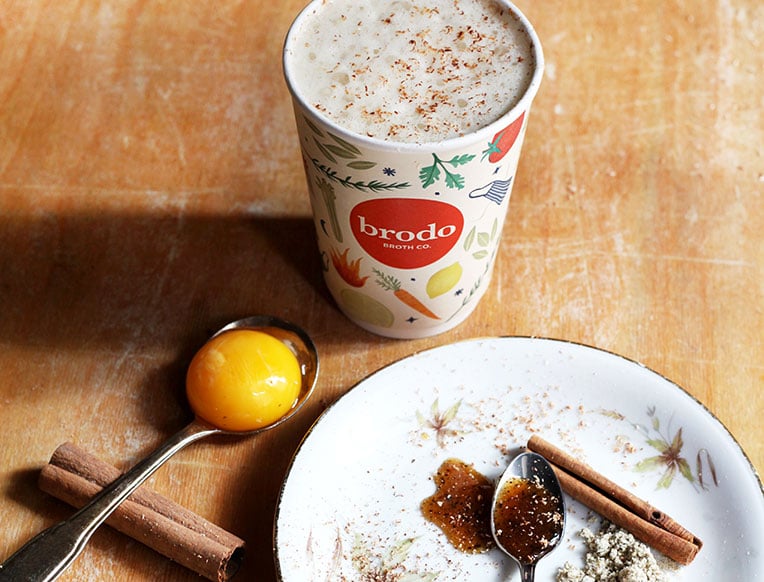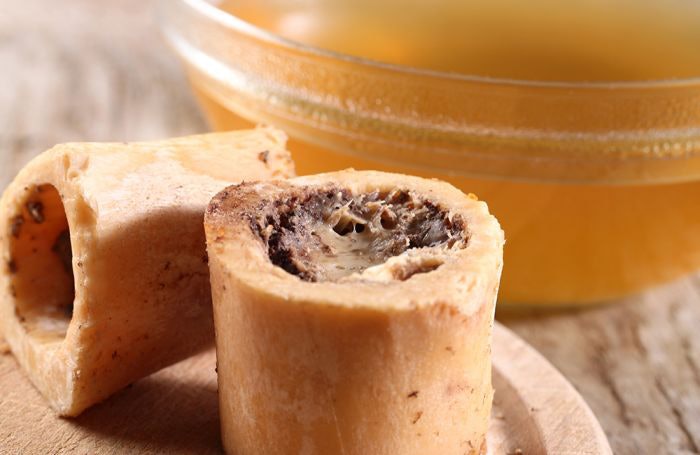How to Make Beef Bone Broth: A Step-by-Step Overview for Delicious Homemade Nutrition
Beef bone broth is a nutritious enhancement to any type of cooking area. It uses many health benefits and can improve a selection of dishes. The process begins with selecting the appropriate bones and components. Comprehending each action is vital for attaining the very best taste and richness. Nonetheless, many home chefs overlook essential methods that can raise their brew. What are these techniques, and exactly how can they change an easy broth right into a cooking staple?
Understanding the Conveniences of Beef Bone Broth
While lots of people take pleasure in the abundant taste of beef bone brew, they might not completely appreciate its various health and wellness advantages. This beneficial elixir is recognized for its high collagen content, which supports joint health and advertises skin elasticity. The amino acids discovered in bone brew, such as glycine and proline, play substantial roles in muscle fixing and digestion wellness. Furthermore, it is rich in minerals like phosphorus, calcium, and magnesium, necessary for keeping solid bones and total well-being. Bone broth also possesses anti-inflammatory properties, which can minimize symptoms connected with chronic conditions. Consuming it might sustain intestine health and wellness by enhancing the mucosal lining of the digestive system, promoting better nutrient absorption. The heat and comfort of a steaming bowl of brew can provide a soothing result, making it a healthy and delicious choice for people looking for both cooking enjoyment and health benefits. Cooking Choosing the Right Bones
The structure of a flavorful and nourishing beef bone brew depends on the choice of bones. For suitable results, it is important to choose a selection of bones that offer an abundant blend of taste and nutrients. Marrow bones, which contain the fatty, gelatinlike marrow, are especially treasured for their capacity to improve the brew's splendor. Joint bones, such as oxtails and knuckles, are likewise beneficial since they are high in collagen, adding to a smooth texture. In addition, consisting of some weighty bones can add depth to the taste account. Sourcing bones from grass-fed or pasture-raised cattle is a good idea, as these alternatives tend to use superior high quality and preference. It is likewise crucial to ascertain the bones are free and fresh from any type of off-putting smells. By carefully picking the right bones, one can lay the groundwork for a nourishing and scrumptious beef bone broth.
Crucial Ingredients for Flavorful Broth
To develop a savory beef bone brew, selecting high quality beef bones is crucial as they serve as the structure of the recipe - Where To Buy Bone Broth Near Me. Fragrant veggies and a cautious choice of seasonings and herbs better improve the broth's deepness and intricacy. With each other, these important active ingredients contribute to a rich and enjoyable taste account
Top Quality Beef Bones
Quality beef bones serve as the structure for a rich and delicious broth. The very best choices include marrow bones, knuckle bones, and oxtails, each contributing one-of-a-kind textures and tastes. Marrow bones are prized for their jelly content, which aids create a silky mouthfeel. Knuckle bones, abundant in collagen, enhance the broth's body and dietary account. Oxtails supply a passionate taste and added richness. It is important to resource bones from grass-fed or pasture-raised cattle, as this enhances the total high quality and flavor of the brew. Quality is also essential; bones must be made use of within a couple of days of acquisition or iced up for later usage. Picking premium beef bones assures a tasty and nourishing end product.
Fragrant Veggies Selection
While choosing aromatic vegetables, one should consider the role they play in boosting the overall flavor profile of the beef bone broth. Typical choices include onions, carrots, and celery, commonly described as the "mirepoix." Onions include sweetness and deepness, while carrots add a subtle earthiness. Celery supplies a revitalizing quality that balances the splendor of the broth. Garlic, though optional, can introduce a durable taste, enhancing the full-flavored notes of the beef. Leeks and shallots are additionally superb enhancements, using special taste dimensions. For a tip of warmth and complexity, some may consist of ginger or fennel. Choosing a combination of these aromatic veggies assures a well-rounded and savory brew, establishing the structure for a nourishing cooking experience.
Flavorful Herbs and Spices
Incorporating savory natural herbs and flavors is crucial for boosting the taste of beef bone broth, as they introduce aromatic intricacy and depth. Usual options consist of bay leaves, which pass on a subtle herbal note, and thyme, known for its natural flavor. Rosemary, with its pine-like essence, adds a revitalizing touch, while parsley contributes illumination and quality. For a hint of heat, black peppercorns and garlic are excellent enhancements, enhancing the brew's general richness. Furthermore, pepper flakes or chili powder can present a mild warm for those that prefer a little seasoning. Picking a balanced mix of these components not just boosts taste however also infuses the broth with valuable nutrients, making it a scrumptious and nourishing alternative for any kind of meal.
Preparing the Bones and Vegetables
To develop a tasty and abundant beef bone broth, the prep work of vegetables and bones is necessary. Selecting high-grade beef bones, such as knuckle, oxtail, or marrow, is essential, as they provide the needed other collagen and nutrients. Toasting the bones in the stove boosts their flavor, giving the brew a much deeper, richer preference. It is advisable to roast them at 400 ° F for regarding thirty minutes, until browned.Next, vegetables play a pivotal function in building flavor. Usual choices include onions, carrots, and celery, known as the mirepoix base. These should be approximately sliced to take full advantage of flavor extraction during simmering. Garlic and tomatoes can also be consisted of for additional depth.Lastly, washing the veggies and bones under cold water assists eliminate any contaminations, guaranteeing a clear brew. Properly preparing bones and veggies sets the structure for a scrumptious and nourishing beef bone broth.
Cooking Approaches: Stovetop vs. Slow Cooker
When it comes to cooking beef bone brew, the choice in between stovetop and slow-moving stove methods provides distinctive benefits. Stovetop cooking permits quicker outcomes and more control over the simmering procedure, while slow cookers provide convenience and a prolonged infusion of flavors. Each approach has its one-of-a-kind advantages, accommodating various choices and timetables.

Stovetop Food Preparation Conveniences
While both stovetop and sluggish stove methods have their qualities, stovetop cooking uses unique advantages that can enhance the procedure of making beef bone broth. One significant benefit is the capability to manage the temperature level and simmering time more exactly, which can lead to excellent extraction of nutrients and tastes from the bones. In addition, stovetop cooking allows for real-time changes, allowing the chef to monitor the broth's uniformity and preference throughout the process. The quicker food preparation time contrasted to reduce cookers can also be advantageous for those needing broth in a shorter timeframe. The stovetop method urges a hands-on approach, fostering a much deeper connection to the food preparation process and potentially resulting in a more delicious end product.
Slow Stove Advantages
Making use of a slow-moving cooker for making beef bone broth uses several distinctive advantages that attract lots of home cooks. One key advantage is the comfort of set-it-and-forget-it cooking. As soon as the components are integrated, the slow-moving cooker can operate neglected for hours, permitting a busy timetable without continuous surveillance. Furthermore, slow stoves maintain a constant low temperature level, which draws out tastes and nutrients successfully over time without the danger of boiling, bring about a richer broth. The power efficiency of slow-moving cookers likewise stands apart, as they use less electricity compared to stovetops (Beef Bone Broth). Sluggish stoves usually have programmable setups, enabling exact control over cooking times, which improves the total convenience of brew prep work.

Stressing and Keeping Your Broth
Straining and storing beef More about the author bone brew is an important step that assures a clear, savory end product. Once the broth has simmered for the advised time, it must be thoroughly poured via a great mesh filter or cheesecloth right into a big dish or pot. This process eliminates any solids, such as meat, veggies, and bones, ensuring a smooth uniformity. To capture every bit of flavor, pressing the solids delicately with a spoon can be beneficial.After straining, the broth ought to cool down to room temperature prior to being kept. It is best to make use of closed containers, such as glass containers or freezer-safe bags, to avoid fridge freezer burn and maintain freshness. Classifying the containers with the date is additionally suggested. The brew can be refrigerated for as much as a week or iced up for several months, making it a convenient enhancement to future dishes. Correct storage warranties that the nutritional advantages and flavors continue to be undamaged.
Creative Ways to Make Use Of Beef Bone Broth
Beef bone broth offers a flexible structure for a selection of dishes, improving both taste and nourishment. Home cooks can incorporate it into stews and soups, supplying a rich base that deepens the overall preference. It can likewise be made use of as a food preparation fluid for grains, such as rice or quinoa, infusing them with included nutrients and flavor.Additionally, beef bone brew functions as an outstanding structure for sauces and sauces, lending complexity and richness to dishes. For those seeking a healthy drink, sipping warm broth can be calming and nourishing. It can also be used in smoothies for a protein boost, though this may require some innovative flavor balancing.Ultimately, beef bone broth not just boosts day-to-day dishes however also contributes to a wholesome diet plan, making it a staple active ingredient for health-conscious people Full Report and cooking lovers alike.
Frequently Asked Questions
The Length Of Time Can I Store Beef Bone Broth in the Refrigerator?
The question of storage duration for beef bone broth in the fridge is necessary. Commonly, it can be securely saved for concerning three to 5 days, ensuring quality and top quality prior to consumption or cold for longer preservation.
Can I Freeze Beef Bone Broth, and for How much time?
Beef bone brew can be iced up successfully, permitting extended storage. When effectively secured in closed containers, it can last approximately six months in the freezer, maintaining its taste and dietary benefits for later usage.
Is It Safe to Make Use Of Bones From a Supermarket?
The security of making use of grocery store bones depends on their resource and handling. If appropriately sourced and kept, these bones can be secure for usage, offering necessary nutrients when prepared appropriately for brew.
Can I Make Beef Bone Broth in an Instant Pot?
The Instantaneous Pot is indeed ideal for making beef bone broth - Bone Broth Near Me. Its stress food preparation attribute significantly lowers cooking time while still removing abundant flavors and nutrients, making it a convenient option for busy home cooks

What Nutritional Differences Exist In Between Beef and Hen Bone Brew?
The dietary differences between beef and chicken bone broth mainly hinge on their collagen web content, amino acids, and mineral accounts. Beef brew generally contains more collagen and minerals, while poultry broth is frequently lighter and much easier to absorb. The structure of a tasty and nutritious beef bone broth exists in the selection of bones. To develop a tasty beef bone broth, selecting quality beef bones is crucial as they serve as the foundation of the dish. The finest options consist of marrow bones, knuckle bones, and oxtails, each contributing special structures and tastes. While choosing aromatic vegetables, one have to take into consideration the duty they play in boosting the general flavor account of the beef bone brew. To create a flavorful and abundant beef bone broth, the prep work of bones and veggies is important.